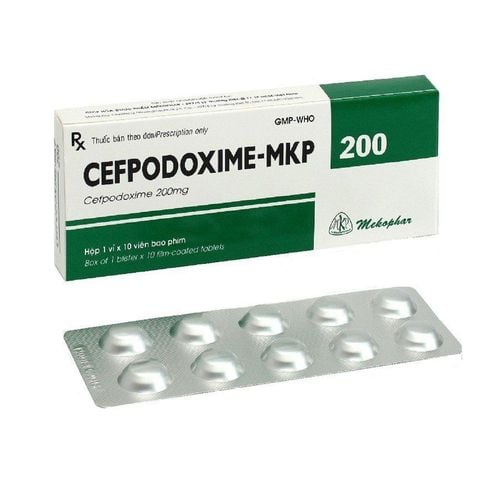This is an automatically translated article.
Hafixim 50 is used in the treatment of infections caused by susceptible bacteria or for the treatment of mild and moderate community-acquired pneumonia... However, some cases of drug use may have adverse effects. Unwanted side effects such as: digestive disorders, flatulence, loss of appetite, nausea, dizziness...
1. Mechanism of action of the drug
Hafixim 50 has the main active ingredient cefixim, a 3rd generation cephalosporin antibiotic with bactericidal effect. The bactericidal mechanism of Hafixim 50 is similar to that of other cephalosporins by binding to target proteins and causing inhibition of mucopeptide synthesis in the bacterial cell wall. The process of antibacterial activity against cefixime is the reduction of the affinity of cefixime with the target protein or may reduce the permeability of the bacterial cell membrane when using the drug.
Cefixime is highly resistant to hydrolysis of beta-lactamases encoded by genes located on plasmids and chromosomes. And studies show that the stability of beta lactamase of cefixime is higher than that of other compounds such as cefaclor, cefoxitin...
Moreover, cefixime is active both in vitro and clinically with most strains bacteria such as: gram-positive bacteria such as streptococcus pneumoniae, gram-negative bacteria such as haemophilus influenzae, E.coli ...
Not only that, cefixime is also effective against in vitro of most strains of bacteria such as streptococcus agalactiae (microbes). Gram-positive bacteria), Haemophilus parainfluenzae (gram-negative bacteria)
However, the cefixime in Hafixim 50 has no activity against some bacteria such as enterococcus, staphylococcus, clostridia, ...
Hafixim 50 contains the following cefixime ingredients. When given, it is possible that 30 to 50% of the dose is absorbed from the gastrointestinal tract, with either before or after a meal. The half-life of Hafixim 50 is usually between 3 and 4 hours and may be longer in patients with renal failure.
When entering the body, the components of Hafixim 50 with 65% of cefixime in the blood will be bound to plasma proteins. Studies have also shown that cefixime has the ability to cross the placenta. And drug concentrations can reach high levels in the bile and urine. According to statistics, after the drug enters the body, about 20% of an oral dose is excreted unchanged in the urine within 24 hours. The remaining 60% of the drug content can be eliminated through the kidneys. Furthermore, Hafixim 50 is not eliminated by hemodialysis.
2. Indications, dosage and usage of Hafixim 50
2.1. Indications and contraindications Hafixim 50mg is used in the treatment of sensitive bacterial infections such as:
otitis media caused by bacteria Haemophilus influenzae, streptococcus pyogenes ... caused. A sore throat and tonsils caused by the bacteria Streptococcus pyogenes. Acute bronchitis and exacerbations of chronic bronchitis caused by Streptococcus pneumoniae, Haemophilus influenzae... Cases of community-acquired pneumonia but in mild and moderate form The disease is caused by uncomplicated urinary tract infections caused by E.coli, proteus mirabilis bacteria. Some cases of pyelonephritis or urinary tract infections caused by susceptible enterobacteriaceae e. However, using Hafixim 50 to treat these cases may have worse treatment results than uncomplicated urinary tract infections. Gonorrhea uncomplicated by neisseria gonorrhoeae or salmonella typhi, or dysentery caused by susceptible shigella bacteria. When using antibiotic Hafixim 50, it is necessary to isolate bacteria and make an antibiotic chart. However, the doctor may prescribe the use of Hafixim 50 before performing the antibiotic if there are signs of suspicion of the causative agent. But when the results of the antibiotic are available, the doctor needs to adjust and monitor the treatment results.
Hafixim 50 may be contraindicated in some cases: hypersensitivity to the drug's ingredients or people with a history of hypersensitivity to beta lactamase antibiotics
2.2 Dosage and how to use Hafixim 50 What is Hafixime? Hafixim 50 is an antibiotic that is used in sachets. When using the drug, dissolve the drug with enough water, about 5 to 10ml of water for a pill pack, then stir the medicine and can be taken before or after a meal.
The duration of treatment with Hafixim 50 depends on the type of infection and can be extended for an additional 48 to 72 hours after the symptoms of infection have disappeared. Therefore, the usual duration of treatment with this drug can be from 5 to 7 days. However, if the infection is caused by group A beta-hemolytic streptococcus bacteria, the treatment period can be extended at least 10 days to prevent rheumatic fever. Or in the case of treatment of lower respiratory tract infections and otitis media, the duration of treatment should be from 10 to 14 days. According to studies reported, Hafixim 50 has not been established to be safe in children under 6 months of age. Therefore, the dose is usually applied to children over 6 months of age. Dosage of Hafixim 50 for children from 6 months to 12 years old will apply at 8mg/kg body weight/day, can be used once a day or divided into two times and each time is 12 hours apart. Adults and children over 12 years old use Hafixim 50 with a dose of 400mg/day, which can be used once a day or divided into two times and each time is 12 hours apart. These subjects can use the drug in an appropriate dosage form, such as a film-coated tablet. Patients with uncomplicated gonorrhea caused by Neisseria gonorrhoeae including beta lactamase strains received a single oral dose of 400 mg. However, it is possible to use a dose higher than 800mg according to the doctor's prescription. For patients with renal failure including adults with creatinine clearance between 21-60ml/min, the dose of cefixime is 300mg/day, and in case of creatinine clearance less than 20ml/min, only the dose should be used. cefixime 200mg/day. The above dosages are for reference only. In the case of treatment with Hafixim 50, the patient should consult and follow the instructions of the treating doctor.
3. Unwanted side effects when using Hafixim 50
In addition to the effects of Hafixim 50, which is effective in treatment, in some cases when using the drug, there may be unwanted side effects. Common side effects include digestive-related conditions such as gastrointestinal upset, diarrhea, abdominal pain, nausea, bloating, loss of appetite, or neurological conditions such as headache, dizziness, restlessness, insomnia, fatigue, or appearance of erythema, urticaria. Some rare cases of undesirable side effects such as severe diarrhea due to clostridium difficile, pseudomembranous colitis, or systemic syndromes such as anaphylaxis, angioedema, Stevens-Johnson syndrome, gangrene toxic epidermal necrolysis, or hematologic manifestations such as transient thrombocytopenia, leukopenia, eosinophilia, decreased hemoglobin concentration, hematocrit, acute renal failure, increased non-protein nitrogen in the blood..
.
4. Be careful when using Hafixim 50
Some notes when using Hafixim 50:
Because Hafixim 50 has skin reactions such as toxic epidermal necrolysis, so stop taking this drug and choose other appropriate measures. when used with people with a history of allergy to penicillins and cephalosporins. Co-administration of Hafixim 50 with probenecid increased peak cefixime concentrations and AUC and decreased renal clearance and volume of distribution. Urine glucose tests with Clinitest, Benedict's solution, Fehling's solution, and coombs' test may give positive results when the patient is taking cefixime during treatment. In summary, the safe use of Hafixim 50 determines the effectiveness of the treatment. Therefore, the patient should follow the instructions and instructions of the doctor about this drug.
Please dial HOTLINE for more information or register for an appointment HERE. Download MyVinmec app to make appointments faster and to manage your bookings easily.













